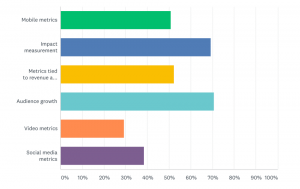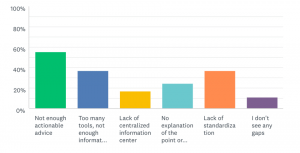Audience Growth & Impact Measurement are Top Priorities for Senior Media Leaders

According to a recent survey from MetricShift, part of the MediaShift media and technology analysis network, audience growth is the top priority for senior media leaders, followed closely by impact measurement.
MetricShift notes that this should not be surprising; demonstrating the impact of marketing activities is a key differentiator for media organizations and can directly drive audience growth.

Compared to 2017’s MetricShift survey investigating media leaders’ priorities, there is a marked increase in the adoption of metrics.
In this year’s survey, more than 56 percent of readers say they track their impact on their audience, meaning more readers and organizations are making informed, data-driven decisions based on analytics.
This adoption of impact measurement across key marketing platforms is possibly due to the increasing number of professionals who started their careers in social media and have since carried this analytical approach with them into more senior roles.
Impact Measurement: Which Audience Growth Metrics Are Most Important?
MetricShift asked readers in their survey which specific metrics they most often tracked. The top ten were:
- Page views
- Time spent
- Unique visitors
- Referrals
- Clicks/CTR
- Engagement metrics
- Google Analytics
- Social media metrics
- Video views
- Ad metrics
However, despite this adoption of wide-ranging metrics, most senior media leaders noted that a key struggle for them was the lack of actionable information presented from their audience analytics.
While many types of analytics are great at identifying challenges or areas for improvement, they rarely offer solutions to these issues. Quantitative insight is rarely useful to a marketer unless they have the information needed to decode and interpret these metrics.
In fact, nearly 40 percent of MetricShift’s readers said there are too many analytics tools available, and not enough information about them.
This feedback shows that a combination of both quantitative and qualitative data is what senior-level staff in media organizations are really looking to measure their audience growth objectives against.
Getting the Right Audience Mix: Quality & Quantity
Measuring your audience growth objectives successfully is only possible if you have aligned these with your goals for different marketing platforms.
For example, why is your brand tweeting ten times per week? Is it to directly generate leads, or increase follower numbers? To drive website traffic, or increase brand awareness?
Knowing the answers to questions like this is essential to make sure you are targeting the right audiences on each platform and measuring the impact of your marketing in the most effective way.
As highlighted by MediaPost, findings from The Audience Growth Survey show that marketers assess their own priorities for growing new digital audiences across email, social media and mobile channels, before deciding how to target and measure their audience.
According to the research, more marketers prioritize selling as a primary objective for email marketing than for social media and mobile channels. As selling is tied to overall ROI, this is consistent with 41% of email marketers who identify overall ROI as the most important measurement to gauge the effectiveness of their email program.
Social media marketers, however, don’t prioritize selling and generating leads as much as driving brand awareness and site traffic. 38% of Facebook marketers and 43% of Twitter marketers say that adding quality fans and followers are the most important measures of effectiveness for their audience growth efforts.
Conclusion
Measuring the impact of your marketing activities, both quantitatively and qualitatively, against your audience growth objectives is fast becoming mandatory for those working in media.
However, you must take the time to consider which metrics are most suitable for measuring your key audience growth objectives across each marketing platform. Adopting a one-size-fits-all approach to your metrics will only serve to constrain your audience growth.
Sources:
 us
us 










